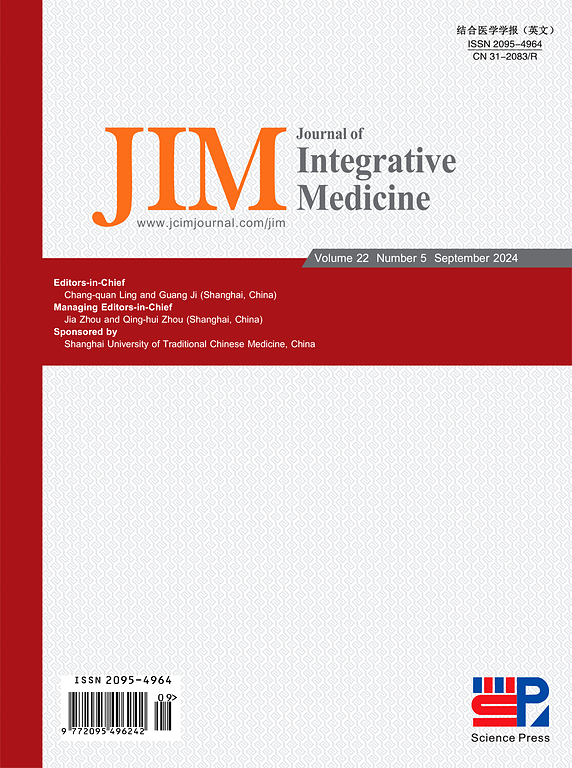Prim-O-glucosylcimifugin mitigates atopic dermatitis by inhibiting Th2 differentiation through LCK phosphorylation modulation
IF 4
2区 医学
Q1 INTEGRATIVE & COMPLEMENTARY MEDICINE
引用次数: 0
Abstract
Objective
To assess the safety and topical efficacy of prim-O-glucosylcimifugin (POG) and investigate the molecular mechanisms of its therapeutic effects in atopic dermatitis (AD).
Methods
The effects of POG on human keratinocyte cell viability and its anti-inflammatory properties were evaluated using cell counting kit-8 assay and reverse transcription-quantitative polymerase chain reaction (RT-qPCR). Subsequently, the impact of POG on the differentiation of cluster of differentiation (CD) 4+ T cell subsets, including T-helper type (Th) 1, Th2, Th17, and regulatory T (Treg), was examined through in vitro experiments. Network pharmacology analysis was used to elucidate POG’s therapeutic mechanisms. Furthermore, the therapeutic potential of topically applied POG was further evaluated in a calcipotriol-induced mouse model of AD. The protein and transcript levels of inflammatory markers, including cytokines, lymphocyte-specific protein tyrosine kinase (Lck) mRNA, and LCK phosphorylation (p-LCK), were quantified using immunohistochemistry, RT-qPCR, and Western blot analysis.
Results
POG was able to suppress cell proliferation and downregulate the transcription of interleukin 4 (Il4) and Il13 mRNA. In vitro experiments indicated that POG significantly inhibited the differentiation of Th2 cells, whereas it exerted negligible influence on the differentiation of Th1, Th17 and Treg cells. Network pharmacology identified LCK as a key therapeutic target of POG. Moreover, the topical application of POG effectively alleviated skin lesions in the calcipotriol-induced AD mouse models without causing pathological changes in the liver, kidney or spleen tissues. POG significantly reduced the levels of Il4, Il5, Il13, and thymic stromal lymphopoietin (Tslp) mRNA in the AD mice. Concurrently, POG enhanced the expression of p-LCK protein and Lck mRNA.
Conclusion
Our research revealed that POG inhibits Th2 cell differentiation by promoting p-LCK protein expression and hence effectively alleviates AD-related skin inflammation.
Please cite this article as: Zhao H, Ma X, Wang H, Ding XJ, Kuai L, Song JK, Zhang Z, Yang D, Gao CJ, Li B, Zhou M. Prim-O-glucosylcimifugin mitigates atopic dermatitis by inhibiting Th2 differentiation through LCK phosphorylation modulation. J Integr Med. 2025; 23(3): 309–319.
prim - o - glucosylcimifgin通过LCK磷酸化调节抑制Th2分化,减轻特应性皮炎。
目的:评价prim-O-glucosylcimifugin (POG)的安全性和局部疗效,探讨其治疗特应性皮炎(AD)的分子机制。方法:采用细胞计数试剂盒-8法和逆转录-定量聚合酶链反应(RT-qPCR)评价POG对人角质形成细胞活力的影响及其抗炎作用。随后,我们通过体外实验研究了POG对辅助性T细胞(Th) 1、Th2、Th17和调节性T细胞(Treg)等cd4 + T细胞亚群分化的影响。采用网络药理学分析阐明POG的治疗机制。此外,在钙三醇诱导的AD小鼠模型中,进一步评估了局部应用POG的治疗潜力。通过免疫组织化学、RT-qPCR和Western blot分析,量化炎症标志物的蛋白和转录水平,包括细胞因子、淋巴细胞特异性蛋白酪氨酸激酶(Lck) mRNA和Lck磷酸化(p-LCK)。结果:POG能抑制细胞增殖,下调白细胞介素4 (Il4)和Il13 mRNA的转录。体外实验表明,POG对Th2细胞的分化有显著抑制作用,而对Th1、Th17和Treg细胞的分化影响可忽略。网络药理学发现LCK是POG的关键治疗靶点。此外,局部应用POG可有效减轻钙泊三醇诱导的AD小鼠模型的皮肤病变,而不会引起肝、肾、脾组织的病理改变。POG显著降低AD小鼠的il - 4、il - 5、il - 13和胸腺基质淋巴生成素(Tslp) mRNA水平。同时,POG增强了p-LCK蛋白和Lck mRNA的表达。结论:我们的研究表明,POG通过促进p-LCK蛋白表达抑制Th2细胞分化,从而有效缓解ad相关性皮肤炎症。赵辉,马鑫,王辉,丁晓军,蒯磊,宋建军,张志,杨东,高家杰,李斌,周明。prim - o - glucothycimifugin通过调控LCK磷酸化抑制Th2分化,缓解特应性皮炎。集成医学[J];打印前Epub。
本文章由计算机程序翻译,如有差异,请以英文原文为准。
求助全文
约1分钟内获得全文
求助全文
来源期刊

Journal of Integrative Medicine-Jim
Medicine-Complementary and Alternative Medicine
CiteScore
9.20
自引率
4.20%
发文量
3319
期刊介绍:
The predecessor of JIM is the Journal of Chinese Integrative Medicine (Zhong Xi Yi Jie He Xue Bao). With this new, English-language publication, we are committed to make JIM an international platform for publishing high-quality papers on complementary and alternative medicine (CAM) and an open forum in which the different professions and international scholarly communities can exchange views, share research and their clinical experience, discuss CAM education, and confer about issues and problems in our various disciplines and in CAM as a whole in order to promote integrative medicine.
JIM is indexed/abstracted in: MEDLINE/PubMed, ScienceDirect, Emerging Sources Citation Index (ESCI), Scopus, Embase, Chemical Abstracts (CA), CAB Abstracts, EBSCO, WPRIM, JST China, Chinese Science Citation Database (CSCD), and China National Knowledge Infrastructure (CNKI).
JIM Editorial Office uses ThomsonReuters ScholarOne Manuscripts as submitting and review system (submission link: http://mc03.manuscriptcentral.com/jcim-en).
JIM is published bimonthly. Manuscripts submitted to JIM should be written in English. Article types include but are not limited to randomized controlled and pragmatic trials, translational and patient-centered effectiveness outcome studies, case series and reports, clinical trial protocols, preclinical and basic science studies, systematic reviews and meta-analyses, papers on methodology and CAM history or education, conference proceedings, editorials, commentaries, short communications, book reviews, and letters to the editor.
Our purpose is to publish a prestigious international journal for studies in integrative medicine. To achieve this aim, we seek to publish high-quality papers on any aspects of integrative medicine, such as acupuncture and traditional Chinese medicine, Ayurveda medicine, herbal medicine, homeopathy, nutrition, chiropractic, mind-body medicine, taichi, qigong, meditation, and any other modalities of CAM; our commitment to international scope ensures that research and progress from all regions of the world are widely covered. These ensure that articles published in JIM have the maximum exposure to the international scholarly community.
JIM can help its authors let their papers reach the widest possible range of readers, and let all those who share an interest in their research field be concerned with their study.
 求助内容:
求助内容: 应助结果提醒方式:
应助结果提醒方式:


